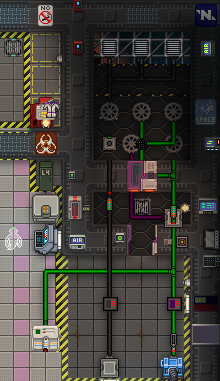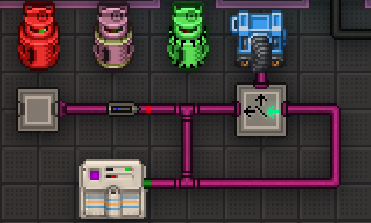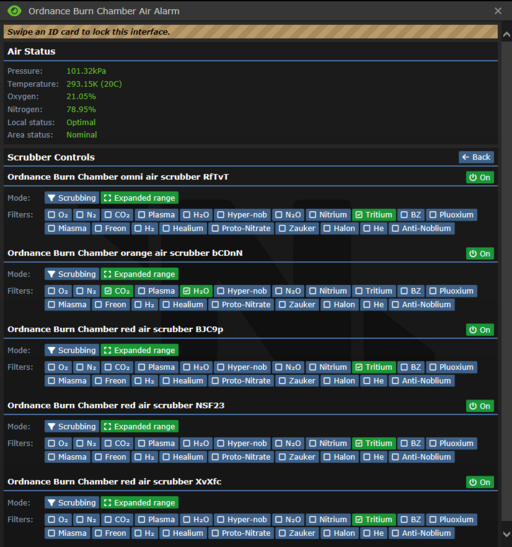User:Neok: Difference between revisions
No edit summary |
No edit summary |
||
| Line 1: | Line 1: | ||
=== Introduction === | === Introduction === | ||
'''Please do not treat this guide as a definitive solution to toxins, I am not an expert, and I highly reccomend you to experiment with other ways to improve upon the process described here.''' | '''Please do not treat this guide as a definitive solution to toxins, I am not an expert, and I highly reccomend you to experiment with other ways to improve upon the process described here.''' | ||
Revision as of 23:16, 27 March 2022
Introduction
Please do not treat this guide as a definitive solution to toxins, I am not an expert, and I highly reccomend you to experiment with other ways to improve upon the process described here.
Experiments
There are currently x experiments you can complete with help of the toxins lab, which can all be found by downloading the NT frontier app on your tablet or modular computer. Completing any of these experiments rewards you with research points, as well as money for the department funds. The exact amount depends on the tier and partner selected, higher tiers reward more, and some partners will reward more funding, while others will reward more points. Finally, some tech options are locked behind certain experiments:
High-Yield Explosives unlocks Advanced Weapon Development Technology
Noblium Gas shells unlocks Quantum Electromagnetic Technology
Nitrium Gas shellsunlocks Advanced Cybernetic Implants
Tritium
A number of experiments, including all needed to unlock technology, require tritium. Tritium is created by mixing oxygen with plasma at high temperatures, preferably at a ratio of 99:1 oxygen to plasma. To do this, we will use the burn chamber conveniently provided to us in the toxins mixing chamber.
Initial Piping
Leave the input loop (black) alone, as it suits our needs for now. Modify the the green (orange on metastation) loop by adding a cooler to it, you will want to connect the red side of the cooler directly into waste, you can move a cooler by screwing the panel open and then right clicking it with a wrench, left click rotates the cooler. Also replace the pipe directly adjacent to the connector with a volume pump, make sure this is OFF. Next acquire a firesuit, open the outer doors blast doors to expose space, and enter the airlock. Inside of the airlock, place down a connector on layer 1 (shown in purple), and cycle the airlock to exterior. Add a scrubber directly behind the door, and pipe this to the connector. Now add 2 additional scrubbers to the green loop. Lastly, add a fourth scrubber facing to space, and connect it to a passive vent in space (shown in black). Important note: opening the chamber to space and adding this black loop helps efficiency, but you'll take damage because of the cold, drink coffee or skip this step to prevent this. This is it for the piping, head back inside.
Use the air alarm next to the burn chamber, and set all scrubbers to extended range. Set the scrubbers connected to the green line to scrub tritium, and turn them all on. Set the black scrubber connected to space to scrub H2O and CO2, and turn it on. Set the purple scrubber connected to the connector to plasma, but keep it off for now.
Next, make sure both of the pumps inside of the airlock are set to 4500kPa.
Finally, yell at science for upgrades for the two coolers. Set both coolers to 30 kelvin (43.15 works too if you dont have higher-tier parts), and turn them on.

Tritium production
Connect an oxygen canister to the input port and wait untill it is empty, repeat this step two more times untill you have emptied three canisters into the burn chamber. Connect a mini pump to output of the burn mix. Create a tier two canister with 10 metal and 5 plasteel, and wrench this in place on the connector in the airlock (shown in red). Next, set the input pump back down to 50kPa, and double check your setup, once you are statisfied, connect a plasma tank to the input and hit the igniter on the wall, the plasma will now burn. After several seconds of the chamber heating up, you should see check the output loop with a gas analyzer, and if all goes well you should see it filling up with tritium. Keep an eye on the tank monitor and wait for the mixture to reach around 15 000 kelvin, once this temperature has been reached, turn on the plasma scrubber on the air alarm, and watch the t2 canister fill up with hot plasma. Once your plasma canister reaches around 3100kPA, turn the scrubber back off. Now wait for the rest of the plasma to be converted into tritium, and once it is cooled pump it into small pump, and you should have several hundred moles, congratulations!
High-yield Bombs
For a tier 3 paper on high-yield bombs, you will need to create a 300 radius bomb, this can be easily done with the help of tritium. First of all get an oxygen and plasma tank, and use a portable scrubber to empty them (on maps missing these, you can use the Huge Air Scrubbers, which currently do not have a sprite, alt click the tiles they are on to acces them). Put the plasma tank in your hot plasma cansister, fill up the tank to maximum pressure(Warning: make sure to close the valve before removing tank, unless you like giving medical and atmospherics more work to do). Next, use the gas mixer to pump one O2 canister into a small pump, then cool this pump to 30 kelvin with the free cooler (43.15 works here as well, but cooler is better). Now put the oxygen tank into your small pump with tritium, set the direction to in and the pressure to 850 kPA, and turn on the pump. Once your tank is filled, turn off the pump and take out the tank. Now put this tank into your small pump with O2, max the pressure, and fill the tank in the same way. Connect both tanks to a tank transfer valve (TTV). Now get a remote signaler, and change the frequency to something you can remember (we change this so you dont accidentally have some assistant trying to pulse a vibrator on the default frequency and instead turning you into gibs). Screwdriver the signaler and attach it to the TTV, congratulations, your bomb is done! Now launch your bomb onto the test site, turn on the intercom next to the Doppler-tachyon array to flex on the crew, and blow up your bomb. Download the data into a disk and dont forget to publish a paper with it!
Low-Yield Bombs
Simply do the exact same as High-Yield Bombs, except you can use far less tritium and oyxgen. Using a pressure of 100kPa tritium, and then filling the tank up to 300kPa with oxygen is plenty for tier 3 Low-Yield. This experiment does not unlock anything, but is easy to do and provides extra points for research.
BZ Gas shells
Gas Shell experiments require you to make a tank fail with a specified amount of a specific type of gas in it. For BZ Gas Shells, you will want to steal borrow the BZ tank from xenobio. Pump about 800 mol into an empty small pump, and then cool this pump down as much as possible with a cooler, getting close 10 kelvin is ideal for this. Empty out a tank, and then pump all 800 mol of BZ into your tank, and place it in the compressor located in the toxins range. Simply connect any other gas (nitrogen is a good choice, if you are going to recycle the BZ for later) to the blue input port, and turn on the compressor. Your tank should now either explode or leak, eject it once it is empty if it is leaking, the machine will then generate a log, download this and publish a paper on it!
Noblium Gas shells
Noblium is a gas created by mixing nitrogen and tritium at under 15 kelvin. This reaction creates a large amount of heat, which can be reduced by adding BZ (BZ will not be consumed if used in this way). Cool down one tank of nitrogen to the same temperature as your tritium (30 kelving if you followed the tritium guide), for ease of mixing. Now clear an area and construct a new loop, Connect this loop to a cooler, add one volume pump with a connector for adding BZ, add one filter that connects to a canister, and pumps the rest back into the loop, lastly add a gas mixer with two connector ports leading into the loop. You will want to configure the filter to remove hyper-noblium, and add a T2 canister to the connector. Next add your BZ canister, and very carefully add around 20-30 mol of BZ into the loop (I recommend setting the pump to 5 l/s or lower). Add your nitrogen to node one on the mixer, and your tritium to node two. Set the mix on the mixer to 66.7% nitrogen, and 33.3% tritium. You only to pump in this mixture untill you have usedaround 50-100 mol of tritium, as that will create enough noblium for the gas shell experiment and leave you with enough to complete nitrium gas shells. Once you are satisfied with the amount of hyper-noblium, cool down your canister, and then transfer all the gas into a small pump and finally into an empty tank to be used in the compressor. Pipe in some random gas to explode the tank, and publish your paper!

Nitrium Gas shells
Creating Nitrium, conveniently, uses the exact same gasses as Hyper-Noblium. Specifically, it uses tritium, nitrogen, and BZ in a ratio of 20:20:1, at a temperature of 1500 kelvin. You can usethe exact same setup as described above, but by invert the cooler, it will now cool the waste loop, dumping excess heat into your loop and heating it up. Make sure the loop is above 15 kelvin so it doesnt create more Hyper-Noblium, and dump in the rest of your tritium. Now set the filter to filter out Nitrium, and place a new canister to collect it.
Important miscellaneous notes
- Unhooking a tank in a canister that is open will flood the room, doing this with a pump will fill the pump with the surrounding air, this is not good.
- Unwrenching pipes will release the contents, be carefull to empty your pipes before removing them. This does not apply to devices like scrubbers, connectors, and pumps, those can be unwrenched without fear.
- Devices like pumps, filters, and even coolers will hold gasses even if the loops connected to them are empty. To make sure you dont contaminate tanks, especially using coolers, unwrench the scrubber pipe connected to them, rebuild the machine and move them to the right orientation, then rebuild the scrubber.
